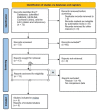A Literature Review of Perioperative Outcomes of Robotic Radical Nephrectomy (RRN) Versus Laparoscopic Radical Nephrectomy (LRN) for Renal Cell Carcinoma (RCC)
- PMID: 38125252
- PMCID: PMC10730983
- DOI: 10.7759/cureus.49077
A Literature Review of Perioperative Outcomes of Robotic Radical Nephrectomy (RRN) Versus Laparoscopic Radical Nephrectomy (LRN) for Renal Cell Carcinoma (RCC)
Abstract
Renal cell carcinoma (RCC) is an adenocarcinoma of the renal cortex. Radical nephrectomy remains the standard of care for managing massive renal tumours. Robotic-assisted radical nephrectomy is an increasing alternative technique to laparoscopic radical nephrectomy (LRN). The da Vinci Surgical System allows for improved dexterity, increased visualisation, tremor filtration and an ergonomic setting to enhance surgeon comfort. The aim was to compare the perioperative outcomes pertaining to operative time, intraoperative complications, blood loss and length of hospital stay between the robotic and LRN for RCC. Studies that compared the perioperative findings between robotic radical nephrectomy (RNN) and LRN for RCC were included. The literature review was carried out according to the Cochrane collaboration standards where applicable. Highly sensitive search strategies like MeSH terms and controlled vocabularies were used to identify relevant studies that compare the RNN outcomes to the LRN. Following the literature search, a total of 73 articles were collected, 60 articles were excluded at the stage of reviewing the titles, eight articles were excluded after reading the abstracts, and five articles were included in this paper. Five studies were included in this analysis, with a total sample size of 1770 patients, 735 were in the robotic arm, and 1035 were in the laparoscopic arm. Generally, there were no differences between both arms in terms of demographic data and age of patients. Closer analysis of the perioperative outcomes did not reveal significant differences between the two groups related to the estimated blood loss, length of hospital stay or post-operative complications. The laparoscopic techniques have less operative time than the robotic ones. RRN is an expanding approach for patients with RCC with some potential technical benefits over laparoscopic ones. RRN is similar to LRN in the perioperative outcomes, with few potential drawbacks of RRN, including higher costs. However, a prospective comparison of RRN with LRN in many cases at multiple centres with long-term oncological results best illustrates the status of RRN versus LRN.
Keywords: laparoscopic radical nephrectomy; radical nephrectomy; renal cancer; robot-assisted laparoscopic nephrectomy; robotic radical nephrectomy.
Copyright © 2023, Alzamzami et al.
Conflict of interest statement
The authors have declared that no competing interests exist.
Figures







References
-
- Reynard J, Brewster SF, Biers S, Neal NL. Naomi Neal, Oxford Handbook of Urology. Vol. 4. Oxford University Press; 2019. Oxford Handbook of Urology.
-
- EAU Guidelines. European Association of Urology Pocket Guidelines. 2020. https://uroweb.org/news/eau-guidelines-2020-now-available-online https://uroweb.org/news/eau-guidelines-2020-now-available-online
-
- Robotic versus laparoscopic radical nephrectomy: a large multi-institutional analysis (ROSULA Collaborative Group) Anele UA, Marchioni M, Yang B, et al. https://pubmed.ncbi.nlm.nih.gov/30734072/ World J Urol. 2019;37:2439–2450. - PubMed
-
- A prospective comparison of laparoscopic and robotic radical nephrectomy for T1-2N0M0 renal cell carcinoma. Hemal AK, Kumar A. https://pubmed.ncbi.nlm.nih.gov/18704439/ World J Urol. 2009;27:89–94. - PubMed
-
- Robotic versus laparoscopic radical nephrectomy: comparative analysis and cost considerations. Helmers MR, Ball MW, Gorin MA, Pierorazio PM, Allaf ME. https://pubmed.ncbi.nlm.nih.gov/27705727/ Can J Urol. 2016;23:8435–8440. - PubMed
Publication types
LinkOut - more resources
Full Text Sources
